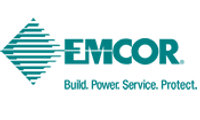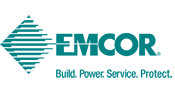
EMCOR Group Inc
NYSE:EME


| US |

|
Johnson & Johnson
NYSE:JNJ
|
Pharmaceuticals
|
| US |

|
Berkshire Hathaway Inc
NYSE:BRK.A
|
Financial Services
|
| US |

|
Bank of America Corp
NYSE:BAC
|
Banking
|
| US |

|
Mastercard Inc
NYSE:MA
|
Technology
|
| US |

|
UnitedHealth Group Inc
NYSE:UNH
|
Health Care
|
| US |

|
Exxon Mobil Corp
NYSE:XOM
|
Energy
|
| US |

|
Pfizer Inc
NYSE:PFE
|
Pharmaceuticals
|
| US |

|
Palantir Technologies Inc
NYSE:PLTR
|
Technology
|
| US |

|
Nike Inc
NYSE:NKE
|
Textiles, Apparel & Luxury Goods
|
| US |

|
Visa Inc
NYSE:V
|
Technology
|
| CN |

|
Alibaba Group Holding Ltd
NYSE:BABA
|
Retail
|
| US |

|
3M Co
NYSE:MMM
|
Industrial Conglomerates
|
| US |

|
JPMorgan Chase & Co
NYSE:JPM
|
Banking
|
| US |

|
Coca-Cola Co
NYSE:KO
|
Beverages
|
| US |

|
Walmart Inc
NYSE:WMT
|
Retail
|
| US |

|
Verizon Communications Inc
NYSE:VZ
|
Telecommunication
|
Utilize notes to systematically review your investment decisions. By reflecting on past outcomes, you can discern effective strategies and identify those that underperformed. This continuous feedback loop enables you to adapt and refine your approach, optimizing for future success.
Each note serves as a learning point, offering insights into your decision-making processes. Over time, you'll accumulate a personalized database of knowledge, enhancing your ability to make informed decisions quickly and effectively.
With a comprehensive record of your investment history at your fingertips, you can compare current opportunities against past experiences. This not only bolsters your confidence but also ensures that each decision is grounded in a well-documented rationale.
Do you really want to delete this note?
This action cannot be undone.

| 52 Week Range |
218.4579
526.95
|
| Price Target |
|
We'll email you a reminder when the closing price reaches USD.
Choose the stock you wish to monitor with a price alert.

|
Johnson & Johnson
NYSE:JNJ
|
US |

|
Berkshire Hathaway Inc
NYSE:BRK.A
|
US |

|
Bank of America Corp
NYSE:BAC
|
US |

|
Mastercard Inc
NYSE:MA
|
US |

|
UnitedHealth Group Inc
NYSE:UNH
|
US |

|
Exxon Mobil Corp
NYSE:XOM
|
US |

|
Pfizer Inc
NYSE:PFE
|
US |

|
Palantir Technologies Inc
NYSE:PLTR
|
US |

|
Nike Inc
NYSE:NKE
|
US |

|
Visa Inc
NYSE:V
|
US |

|
Alibaba Group Holding Ltd
NYSE:BABA
|
CN |

|
3M Co
NYSE:MMM
|
US |

|
JPMorgan Chase & Co
NYSE:JPM
|
US |

|
Coca-Cola Co
NYSE:KO
|
US |

|
Walmart Inc
NYSE:WMT
|
US |

|
Verizon Communications Inc
NYSE:VZ
|
US |
This alert will be permanently deleted.
 EMCOR Group Inc
EMCOR Group Inc
EMCOR Group Inc
In the dynamic world of construction and facilities services, EMCOR Group Inc. stands out as a formidable player, ingeniously merging engineering expertise with operational efficiency. Born from a history of strategic acquisitions and expansions, EMCOR's roots trace back to the conglomerate Jamaica Water Supply Company, transforming over the years into a diversified enterprise. As the company expanded, it carved out a unique niche through its proficiency in mechanical and electrical construction services. The core of EMCOR's operations revolves around designing, constructing, and maintaining complex systems for commercial and government facilities. Their employees, a team of highly skilled engineers, technicians, and project managers, ensure that structures such as hospitals, data centers, and airports operate seamlessly. By focusing on high-demand sectors like healthcare, technology, and energy, EMCOR aligns its services with industries that require robust, innovative solutions, cementing its reputation for reliability and excellence.
EMCOR's savvy business model thrives on its capacity to deliver both comprehensive facilities maintenance and scalable construction services. The company generates revenue by maintaining long-term service contracts and tackling significant construction projects. This dual focus allows EMCOR to harness the steadiness of recurring revenue from maintenance agreements, while simultaneously pursuing growth through large-scale construction ventures. Further enhancing its profitability, EMCOR leverages technological advances such as energy-efficient systems, contributing to both client satisfaction and environmental sustainability. Notably, the company’s resilience during economic downturns is largely attributed to its diversified portfolio and strategic focus on sectors that consistently demand maintenance and upgrades, providing a buffer against cyclicality and underpinning steady financial growth. Through this multifaceted approach, EMCOR not only sustains its operational momentum but also continuously adapts to the evolving commercial landscape.

In the dynamic world of construction and facilities services, EMCOR Group Inc. stands out as a formidable player, ingeniously merging engineering expertise with operational efficiency. Born from a history of strategic acquisitions and expansions, EMCOR's roots trace back to the conglomerate Jamaica Water Supply Company, transforming over the years into a diversified enterprise. As the company expanded, it carved out a unique niche through its proficiency in mechanical and electrical construction services. The core of EMCOR's operations revolves around designing, constructing, and maintaining complex systems for commercial and government facilities. Their employees, a team of highly skilled engineers, technicians, and project managers, ensure that structures such as hospitals, data centers, and airports operate seamlessly. By focusing on high-demand sectors like healthcare, technology, and energy, EMCOR aligns its services with industries that require robust, innovative solutions, cementing its reputation for reliability and excellence.
EMCOR's savvy business model thrives on its capacity to deliver both comprehensive facilities maintenance and scalable construction services. The company generates revenue by maintaining long-term service contracts and tackling significant construction projects. This dual focus allows EMCOR to harness the steadiness of recurring revenue from maintenance agreements, while simultaneously pursuing growth through large-scale construction ventures. Further enhancing its profitability, EMCOR leverages technological advances such as energy-efficient systems, contributing to both client satisfaction and environmental sustainability. Notably, the company’s resilience during economic downturns is largely attributed to its diversified portfolio and strategic focus on sectors that consistently demand maintenance and upgrades, providing a buffer against cyclicality and underpinning steady financial growth. Through this multifaceted approach, EMCOR not only sustains its operational momentum but also continuously adapts to the evolving commercial landscape.






























 You don't have any saved screeners yet
You don't have any saved screeners yet
